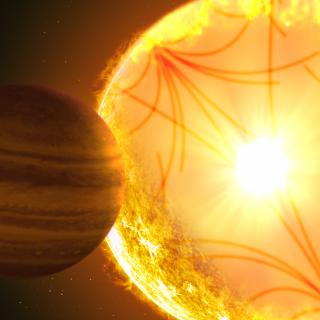Bibcode
Alonso, R.; Auvergne, M.; Baglin, A.; Ollivier, M.; Moutou, C.; Rouan, D.; Deeg, H. J.; Aigrain, S.; Almenara, J. M.; Barbieri, M.; Barge, P.; Benz, W.; Bordé, P.; Bouchy, F.; de La Reza, R.; Deleuil, M.; Dvorak, R.; Erikson, A.; Fridlund, M.; Gillon, M.; Gondoin, P.; Guillot, T.; Hatzes, A.; Hébrard, G.; Kabath, P.; Jorda, L.; Lammer, H.; Léger, A.; Llebaria, A.; Loeillet, B.; Magain, P.; Mayor, M.; Mazeh, T.; Pätzold, M.; Pepe, F.; Pont, F.; Queloz, D.; Rauer, H.; Shporer, A.; Schneider, J.; Stecklum, B.; Udry, S.; Wuchterl, G.
Referencia bibliográfica
Astronomy and Astrophysics, Volume 482, Issue 3, 2008, pp.L21-L24
Fecha de publicación:
5
2008
Revista
Número de citas
209
Número de citas referidas
165
Descripción
Context: The CoRoT mission, a pioneer in exoplanet searches from space,
has completed its first 150 days of continuous observations of ~12 000
stars in the galactic plane. An analysis of the raw data identifies the
most promising candidates and triggers the ground-based follow-up. Aims: We report on the discovery of the transiting planet
CoRoT-Exo-2b, with a period of 1.743 days, and characterize its main
parameters. Methods: We filter the CoRoT raw light curve of cosmic
impacts, orbital residuals, and low frequency signals from the star. The
folded light curve of 78 transits is fitted to a model to obtain the
main parameters. Radial velocity data obtained with the SOPHIE, CORALIE
and HARPS spectrographs are combined to characterize the system. The 2.5
min binned phase-folded light curve is affected by the effect of
sucessive occultations of stellar active regions by the planet, and the
dispersion in the out of transit part reaches a level of
1.09×10-4 in flux units. Results: We derive a
radius for the planet of 1.465 ± 0.029 R_Jup and a mass of 3.31
± 0.16 M_Jup, corresponding to a density of 1.31 ± 0.04
g/cm^3. The large radius of CoRoT-Exo-2b cannot be explained by current
models of evolution of irradiated planets.
Based on observations obtained with CoRoT, a space project operated by
the French Space Agency, CNES, with participation of the Science
Programme of ESA, ESTEC/RSSD, Austria, Belgium, Brazil, Germany and
Spain; and on observations made with SOPHIE spectrograph at Observatoire
de Haute Provence, France (PNP.07 A.MOUT), CORALIE, and HARPS
spectrograph at ESO La Silla Observatroy (079.C-0127/F)).
Table 2 is only available in electronic form at http://www.aanda.org
Proyectos relacionados

Sismología Solar y Estelar y Búsqueda de Exoplanetas
Los objetivos genéricos de este Proyecto son: 1) el estudio de la estructura y dinámica del interior solar, 2) la extensión de dicho estudio al caso de otras estrellas, 3) la búsqueda y caracterización de planetas extrasolares por métodos fotométricos (principalmente mediante el método de tránsitos) y espectroscópico (variaciones en la velocidad
Savita
Mathur